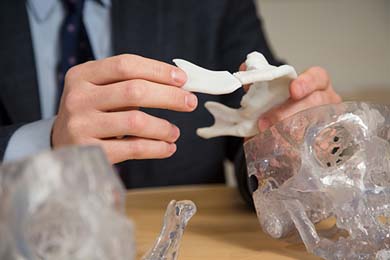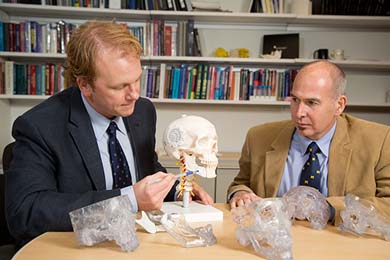Sean Edwards, MD, knows what car accidents, guns, and cancer surgery can do to the delicate structure of the human face. As a professor of surgery and chief of the Pediatric Oral and Maxillofacial Surgery Service at the U-M C.S. Mott Children’s Hospital, he repairs the damage and give his patients as normal an appearance as possible.
Sometimes this means building them a new face.

Facial reconstructive surgery is often akin to assembling pieces of a puzzle. (Photo: Scott Soderberg, Michigan Photography.)
To do this, Edwards creates what surgeons call a flap. It’s made from cut-up pieces of the patient’s fibula, or leg bone, which he assembles like a puzzle to create a new jaw, cheek, or eye socket. Once the underlying skeletal structure is in place, he adds pieces of muscle and soft tissue and then connects the flap to an artery in the neck to keep the transplanted tissue alive. The operation can take 15-18 hours and, in spite of his best efforts, often produces mixed results.
“The problem is that the fibula doesn’t look like the face,” explains Edwards. “I can cut it into pieces and shape it to the face, but it’s not perfect. When I put bone in, I have to put it precisely in the right space in all three dimensions. Where I put the pieces is vital to what the patient will look like and to the quality of function [he/she] gets from the reconstruction.”
Like most surgeons, Edwards is always looking for new ways to improve outcomes. About five years ago, he heard another pediatric surgeon talking about a U-M researcher who was experimenting with tissue-engineered tracheas for children born with tracheal abnormalities that make it difficult to breathe and swallow.
“I was like, ‘Wow, he can do this kind of stuff? Who is this guy?'” recalls Edwards. “That guy” was Scott Hollister, PhD, a professor of biomedical engineering and associate professor of surgery. Hollister and Edwards got together and started talking about how to build a better flap. First, Hollister had to learn about facial reconstruction surgery. Edwards, meanwhile, needed to understand how computer modeling worked and what was possible in the field of tissue engineering. So they read each other’s papers and presentations. They drew pictures and passed them back and forth. When Edwards was tied up in surgery, they convened in the OR.

Sean Edwards and Scott Hollister combine expertise to arrive at a new solution to an old problem. (Photo: Scott Soderberg, Michigan Photography.)
Together they created a library of algorithms to define human facial anatomy in terms computers can understand. Because everyone’s face is different, Hollister wrote software to incorporate measurements from patient CT scans into his computer modeling system and create a three-dimensional computer image of each patient’s skull. The data was sent to a 3-D rapid prototyping machine, which used a laser beam to build an exact plastic replica of the patient’s skull.
“With our computer model, digital scans of the patient’s face and fibula, and the 3-D replica of the patient’s skull, we can plan the surgery in advance,” Hollister explains. “We sit down with Dr. Edwards and his residents to digitally cut the fibula and determine the best way to resurface it and place it in the patient’s face. We have done this for about 15 patients now and find it cuts several hours off the time required for the surgery.”
Encouraged by their success on composite bone reconstruction for facial injuries, Hollister and Edwards are taking the project to the next level. Their goal is to build a pre-fabricated reconstructive flap using a biodegradable polymer scaffold seeded with a patient’s bone and tissue cells. The flap would be inserted in the patient’s back muscle to grow until it’s ready to be implanted in the patient’s face. The project is still in the animal research stage, but Edwards soon plans to implant the first experimental flaps in pigs. If it works in pigs, the U-M researchers believe tissue-engineered flaps could revolutionize the field of facial reconstructive surgery.
“It’s exciting to work with surgeons, because they are so open and amenable to collaboration and they really want to push the field forward,” says Hollister. “We each have a piece of the puzzle.”
Related: Is That an Ear in Your Pocket?
Related: Joint Department of Biomedical Engineering links Medical School and College of Engineering
This suite of stories originally appeared in the Fall 2012 issue of Medicine at Michigan, the alumni magazine for the University of Michigan Medical School.



Rey Rivera - 2005
Pure genius!!!
Reply